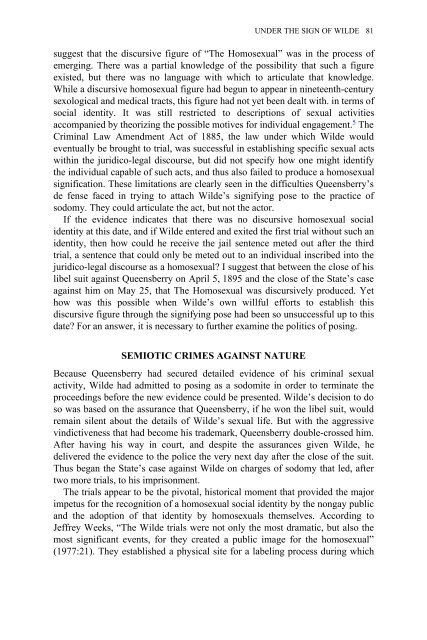Edited by Moe Meyer - Get a Free Blog
Edited by Moe Meyer - Get a Free Blog
Edited by Moe Meyer - Get a Free Blog
Create successful ePaper yourself
Turn your PDF publications into a flip-book with our unique Google optimized e-Paper software.
suggest that the discursive figure of “The Homosexual” was in the process of<br />
emerging. There was a partial knowledge of the possibility that such a figure<br />
existed, but there was no language with which to articulate that knowledge.<br />
While a discursive homosexual figure had begun to appear in nineteenth-century<br />
sexological and medical tracts, this figure had not yet been dealt with. in terms of<br />
social identity. It was still restricted to descriptions of sexual activities<br />
accompanied <strong>by</strong> theorizing the possible motives for individual engagement. 5 The<br />
Criminal Law Amendment Act of 1885, the law under which Wilde would<br />
eventually be brought to trial, was successful in establishing specific sexual acts<br />
within the juridico-legal discourse, but did not specify how one might identify<br />
the individual capable of such acts, and thus also failed to produce a homosexual<br />
signification. These limitations are clearly seen in the difficulties Queensberry’s<br />
de fense faced in trying to attach Wilde’s signifying pose to the practice of<br />
sodomy. They could articulate the act, but not the actor.<br />
If the evidence indicates that there was no discursive homosexual social<br />
identity at this date, and if Wilde entered and exited the first trial without such an<br />
identity, then how could he receive the jail sentence meted out after the third<br />
trial, a sentence that could only be meted out to an individual inscribed into the<br />
juridico-legal discourse as a homosexual? I suggest that between the close of his<br />
libel suit against Queensberry on April 5, 1895 and the close of the State’s case<br />
against him on May 25, that The Homosexual was discursively produced. Yet<br />
how was this possible when Wilde’s own willful efforts to establish this<br />
discursive figure through the signifying pose had been so unsuccessful up to this<br />
date? For an answer, it is necessary to further examine the politics of posing.<br />
SEMIOTIC CRIMES AGAINST NATURE<br />
UNDER THE SIGN OF WILDE 81<br />
Because Queensberry had secured detailed evidence of his criminal sexual<br />
activity, Wilde had admitted to posing as a sodomite in order to terminate the<br />
proceedings before the new evidence could be presented. Wilde’s decision to do<br />
so was based on the assurance that Queensberry, if he won the libel suit, would<br />
remain silent about the details of Wilde’s sexual life. But with the aggressive<br />
vindictiveness that had become his trademark, Queensberry double-crossed him.<br />
After having his way in court, and despite the assurances given Wilde, he<br />
delivered the evidence to the police the very next day after the close of the suit.<br />
Thus began the State’s case against Wilde on charges of sodomy that led, after<br />
two more trials, to his imprisonment.<br />
The trials appear to be the pivotal, historical moment that provided the major<br />
impetus for the recognition of a homosexual social identity <strong>by</strong> the nongay public<br />
and the adoption of that identity <strong>by</strong> homosexuals themselves. According to<br />
Jeffrey Weeks, “The Wilde trials were not only the most dramatic, but also the<br />
most significant events, for they created a public image for the homosexual”<br />
(1977:21). They established a physical site for a labeling process during which


